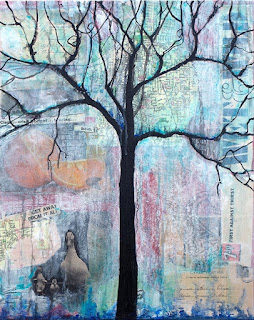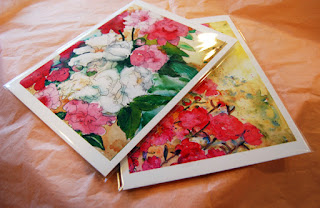This post offers a behind-the-scenes look at how artists price their work, and some clear guidelines to get you started with pricing your own.
One of the most frequently asked questions I get from my students who want to get started pricing their art is how much to charge. All artists struggle with this no matter how long they have been selling their art leaving them wondering if their is left unsold because they raised their prices too quickly, if the art market has gone sour or if collectors are just not interested in their new art.
Sound familiar?
You are not alone and it's not your fault.
No one is born knowing how to price art, just as none of us are born knowing how to do their taxes or price real estate. It’s a skill to be learned and tested, and a very important one because we live in a time of abundant opportunity to get our work seen by people who want to collect it. We can learn to approach our pricing with ease to make our transactions, however personally satisfying they are, become systematized and stress-free.
Emotion Free Guide to Pricing Art
First of all, it is important to understand that there are many paths to pricing art, but each follows structure that prioritizes logic over emotion.
Start with size
Many artists set their pricing according to size, not necessarily by square inch, but by the overall size of the work.
This system will work for you if:
- You generally create your pieces with the same amount of detail.
- You tend to work with the same combination of materials.
- It takes you about the same amount of time for each work in a particular size.
"Pricing by the size of the piece works best for me. I take into consideration what medium I've used and whether or not it's been framed. If the piece is ready to hang like a cradled board or wrapped canvas I charge more for it than if the painting is on paper unframed and unmatted. Also, I like to add domestic shipping into the price."
~ Blenda Tyvoll
Move on to your medium
You also need to take into consideration the medium that you are working in, Paintings are more valuable than drawings. Oil paintings on canvas fetch higher prices than watercolors etc. So whether you work in multiple mediums or you are comparing the prices of your art to another artist be sure you take that into account.
Considerations:
- Oil paintings, for whatever reason, get higher prices than acrylics. Oil is considered by the art market to be the most archival of all mediums and the most sought after by collectors.
- Works on paper sell for far less than works on canvas or boards of the same size. This is usually because works on paper require additional framing in order to be presented, while works on canvas or board can often be hung with a simple frame or no frame at all.
- In general, oil paintings fetch prices 30% higher than similar water based medium such as acrylic or watercolor.
 |
| Rebecca Korpita, "Holiday at the Seashore", 16x20", $595. korpita.com
|
As artist Rebecca Stringer Korpita says, "I price by the size of my piece, the medium and whether it is on paper or canvas. I try to stay consistent even though it is hard not to take into consideration the time spent on the piece or if I personally value it more. If it is a commission, I also price on the number of subjects and the difficulty of the piece (subject matter and clarity of photos provided since I normally work from photos). I require one-half of the cost upfront and the rest upon approval of image. If it is a large piece, I usually include shipping into the price. For smaller pieces, shipping is added. I also look around to see what other artists are charging for similar sizes."
Pay attention to the Presentation
A lot of my students ask how they can increase the value of their work or improve their art. The single best way to increase the value of your work, without much effort, is in the presentation.
This means sealing your work, framing, and showcasing your artwork professionally.
You might be thinking “that’s expensive” and if you are, you might also be creating that very same reaction in other people when you present your latest watercolors to them in a ziplock bag. If you present your work with a dime store marketing approach, you must be prepared for the results.
Luckily, you don’t have to break your bank in order to present your work professionally. You also should never spend a lot of money on framing only to discover that your dream client wants a different frame anyway.
Frame just one
One approach some artists like is to find a local frame shop to call “your” framer and price out your preferred framing choices along with researching the shop’s turn-around time. You can then have one piece framed beautifully. That piece will be your presentation piece that you will show to clients first so they can fall in love with your work, or that you will use to photograph your work in a room if you are selling online. The good news is that if the client likes your choice of framing and wants another, you already have the information written down, already know the cost to add on, and will sound like a pro when you say “No problem, I’ll send it to my framers, and they’ll have it ready for you in two weeks.”
Sell Works on Paper Unframed (but well presented!)
On the other hand, I have found that framing is very personal and clients like it to match their decor. Therefore, I prefer to sell unframed works professionally wrapped in clear acetate sleeves, mats and acid-free foam backing boards. I get all of mine in bulk from an east coast supplier whom I've been working with for years. Their name is
Stu-Art Supples, and you should tell them Miriam Schulman sent you!
The sleeves keep fingerprints off of your originals, and also make the work easy to transport. Since I create my watercolor in the same sizes, I have them matted to sizes that fit ready made frames. That way I can tell my customers that they do not have to custom frame the art since it already fits ready made frames. I do the same with my prints. (btw, I do have a
mini-course in how to make and package prints at the Inspiration Place called
Print Apprenticeship)
If I am selling the art framed, I usually add double the cost of framing, and round it up a little, to the price of the work. The reason I double the framing cost is if you are selling through a gallery that takes a commission, they will be taking about half the price of the sale and you do not want to lose money on the framing. This is why I only sell canvases in a simple black floater frame that does not cost as much. For my works on paper, I generally sell them matted as described previously but unframed for the same reason.
Keep your pricing consistent
Keep your pricing consistent, and don’t inflate your framing costs. You are adding convenience to your customer but the higher price may be a turn off. Whether you are paying for frames or mats, be sure your framer or mat supplier has your tax ID on file. Since you are a reseller there is no need to pay tax on items that you plan to charge tax for yourself.
Selling History
We are creating art, but we are also creating intellectually property that is for sale. It is important to not only keep track of who buys your work, but keep track of how much they are paying for it. I use
ArtworkArchive.com as my database for art sales and contact information. As you move into new venues, each venue comes with its own sales environment, and so as a working artist, be aware that it is your job to present your work in places where your selling prices and their selling prices are in the same range. Note how I used the words “selling prices” - make sure the venue actually
sells work at the prices you have set. For example, if the average selling price of a gallery is $600, you can't go in and expect your art to sell in the thousands even if you get those prices elsewhere unless you are bringing in your own customers!
Pricing too low rarely works
Moreover, underselling the gallery can also backfire. If the average price of art in the gallery is $600, you may have trouble moving art at $200 because customers might wonder what's wrong with it.
You will gradually increase your pricing when you run low on inventory and then release a new body of work, but it is not advised to make jumps of more than 10% of your current selling price at a time.
Trophy Sales
Tonalist painter Jan Schmuckal advises caution when you get a trophy sale. For example, she recently sold out of her paintings which were priced at a premium by her art dealer. As she says, "I do allow all of my vendors to set their own prices.....as they know their markets best. I shipped 12 paintings to a vendor who set up at a show this weekend and I had increased my prices a bit, so I was worried. I should not have worried. The show opened at noon on Fri and ALL of my paintings had sold by 1 pm. I do know why though- which has a lot less to do with pricing than human behavior - one fellow who collects my work happened to be at the show and he made a beeline for the booth right after it opened and he bought FOUR right off the bat. Thus chumming the water. That's an awesome thing to have happen, but it is an aberration, so I will not use that to increase prices. "
Paintings don't go bad
Sometimes your art is priced right, but the right seller hasn't come along yet. (This may mean you have to step up your marketing efforts.) As artist Patricia Rizzo says, "One more thing...paintings don't go bad. If they're good, hang onto them and the right buyer will come along eventually."
Finally, Have A Look at Your Competition
As artists, we joke about competition because we know that art is such a personal thing, but in the marketplace, we can benefit from comparing our pricing to that of active artists who are similar stages in their career. No need comparing your price to the artist whose art hangs in the Moma but perhaps there is an artist on Etsy who with a sales history you can research.
The point is that you are judging the price points your ideal customer is comfortable with. An buyer on Etsy is looking for a lower price point than an art collector on Saatchi. Both online art collectors may be at lower price points than one who is used to New York gallery prices
It's called market research
This is called market research, and as much as it might feel like you are stalking other people, you are really just collecting market information on comparable works to yours in order to determine the prices for your art according to
size, medium, finish, and
market research.
To Sum It Up: There Is No Formula, Only Guidance
You may have come to this article looking for a magic art calculator, only to find that the way to price art is by researching your market according to guidelines. Research is simply a matter of using online resources, such as
Saatchi Online or
Etsy to find comparable works according to size and medium, or by visiting your local galleries to see the sales environment around you.
Even in the most high end galleries, or even when purchasing real estate, pricing is determined by showing comparable items. And so, I hope you find this clarity alleviates the emotional side of pricing your work, and provides you with comfort in knowing that even the most prolific and successful artists are still doing this very same process of researching the value of art in the marketplace. I know it can be emotional and we always believe our most recent effort is our very best (and it is!) but don't forget in a few months that piece of art will be as long forgotten as your ex-boyfriend.
As contemporary artist Eden Folwell says, “Take the emotion out of it and price your work and move on. Re-evaluate your career periodically, not too often, and decide if any major events have taken place to justify an increase. Be brutal. Don't just charge more because you feel like it. Did a major museum purchase your work? Was your work featured in a film? There has to be a reason to raise prices and collectors get the jitters if your pricing isn't stable and logical."
I created this pin just for you!
Are you wanting to learn more about the business side of art?

About the Artist (Miriam Schulman)
In case we haven’t met yet, I’m a watercolor and mixed media artist. My art has been featured in numerous publications such as
Somerset Studio, and I
’m the founder of The Inspiration Place where I give my students stepping stones to create beautiful art as well as the emotional support they need to stay inspired. See the art I create at
schulmanArt.com or learn how to paint with me at
TheInspirationPlace.net
PS You may have noticed that I have turned commenting OFF on my blog.
That is because most blogs, even very popular ones, do not receive many comments and I wanted to switch the focus from begging for comments to helping you.
However, I AM interested in continuing the conversation which is why I started a
FREE Inspiration Place community on facebook. Please join us!!















